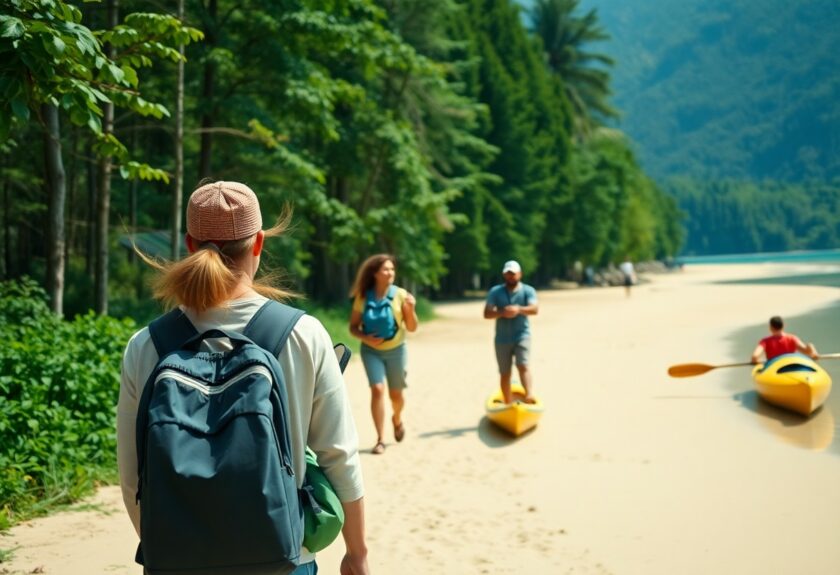When it comes to hiking, the right gear can make all the difference, not only in terms of comfort and safety but also in minimizing environmental impact. Sustainable hiking gear is designed with eco-friendly materials and ethical manufacturing processes, ensuring that your outdoor adventures leave a lighter footprint on the planet. For instance, many brands now offer backpacks made from recycled plastics or organic cotton, which not only reduces waste but also supports a circular economy.
Footwear is another critical component; many companies are producing hiking boots and shoes using sustainable materials like hemp, natural rubber, and recycled components. These innovations not only enhance performance but also align with a growing commitment to environmental stewardship. In addition to the materials used, the longevity and durability of hiking gear play a significant role in sustainability.
Investing in high-quality items that can withstand the rigors of various terrains and weather conditions means fewer replacements over time, which ultimately reduces waste. Furthermore, many outdoor brands are adopting repair programs, encouraging consumers to fix rather than discard their gear. This shift towards a more sustainable mindset is essential for fostering a culture of conservation among outdoor enthusiasts.
By choosing gear that is both functional and environmentally responsible, hikers can enjoy their adventures while contributing to the preservation of the natural landscapes they cherish.
Eco-Friendly Camping Essentials
Camping is a beloved pastime for many, offering an opportunity to connect with nature and escape the hustle and bustle of daily life. However, traditional camping gear often comes with a hefty environmental cost. To mitigate this impact, eco-friendly camping essentials have emerged as a viable alternative.
From tents made of recycled materials to biodegradable soap for washing dishes, these products are designed to minimize harm to the environment while still providing comfort and convenience. For example, solar-powered lanterns and chargers not only reduce reliance on fossil fuels but also harness the sun’s energy, making them an excellent choice for eco-conscious campers. Moreover, sustainable camping practices extend beyond just gear; they encompass the entire camping experience.
Choosing to camp in designated areas that promote conservation and responsible use of natural resources is crucial. Many eco-friendly campsites implement practices such as composting toilets and recycling programs, further enhancing their commitment to sustainability. Additionally, opting for locally sourced food and reusable containers can significantly reduce waste and carbon emissions associated with food transportation.
By embracing these eco-friendly camping essentials and practices, outdoor enthusiasts can enjoy their time in nature while actively contributing to its preservation.
Leave-No-Trace Principles for Outdoor Adventures

The Leave-No-Trace principles serve as a guiding framework for outdoor enthusiasts who wish to minimize their impact on the environment while enjoying nature’s beauty. These principles emphasize the importance of planning ahead and preparing for outdoor activities to ensure that one is equipped to handle various situations without harming the ecosystem. For instance, understanding local regulations regarding campfires, wildlife interactions, and waste disposal can significantly reduce one’s ecological footprint.
By educating oneself about the area being visited, adventurers can make informed decisions that protect fragile habitats and preserve the natural landscape for future generations. In addition to preparation, practicing Leave-No-Trace principles involves being mindful of one’s actions while in nature. This includes staying on designated trails to prevent soil erosion and protecting native plants, as well as properly disposing of waste by packing out what you bring in.
Furthermore, respecting wildlife by observing from a distance and not feeding animals helps maintain their natural behaviors and habitats. By adhering to these principles, outdoor enthusiasts not only enhance their own experiences but also contribute to the collective effort of preserving our planet’s natural beauty for others to enjoy.
Green Tips for Winter Outdoor Activities
Winter presents unique challenges and opportunities for outdoor enthusiasts seeking eco-friendly adventures. As temperatures drop and snow blankets the landscape, it becomes essential to adapt our activities in ways that minimize environmental impact. One effective strategy is to choose winter sports that have a lower carbon footprint, such as snowshoeing or cross-country skiing, rather than relying on motorized options like snowmobiles.
These activities not only provide an excellent workout but also allow participants to immerse themselves in the serene beauty of winter landscapes without disturbing wildlife or contributing to air pollution. Additionally, when engaging in winter activities, selecting sustainable clothing is paramount. Layering with materials such as merino wool or recycled polyester can provide warmth without compromising breathability or comfort.
Moreover, investing in high-quality outerwear that is designed for longevity reduces the need for frequent replacements, further minimizing waste. It’s also important to consider transportation methods; carpooling with friends or utilizing public transport can significantly reduce carbon emissions associated with travel to winter destinations. By implementing these green tips during winter outdoor activities, adventurers can enjoy the season’s splendor while remaining committed to environmental responsibility.
Eco-Friendly Summer Outdoor Adventures
As summer arrives, outdoor enthusiasts are presented with a plethora of opportunities for eco-friendly adventures that celebrate the season’s warmth and vibrancy. From hiking along scenic trails to kayaking on pristine lakes, there are countless ways to enjoy nature while prioritizing sustainability. One popular option is to explore local parks and natural reserves that promote conservation efforts and provide educational resources about local ecosystems.
Engaging in activities such as birdwatching or nature photography not only fosters a deeper appreciation for biodiversity but also encourages responsible stewardship of these precious environments. Moreover, summer is an ideal time for community involvement through organized clean-up events or conservation projects. Many organizations host volunteer days where individuals can contribute their time and effort toward preserving local habitats.
Participating in these initiatives not only benefits the environment but also fosters a sense of camaraderie among like-minded individuals who share a passion for protecting nature. Additionally, opting for eco-friendly gear such as reusable water bottles and biodegradable sunscreen can further enhance your summer adventures while minimizing waste and harmful chemicals in delicate ecosystems.
Sustainable Fall Outdoor Activities

As autumn paints the landscape with vibrant hues of red, orange, and gold, it beckons outdoor enthusiasts to embrace sustainable activities that celebrate the season’s beauty. One popular fall activity is hiking through scenic trails adorned with colorful foliage. Choosing trails that are well-maintained helps protect fragile ecosystems while allowing hikers to immerse themselves in nature’s splendor.
Additionally, participating in guided nature walks or educational programs offered by local parks can deepen one’s understanding of seasonal changes and the importance of conservation efforts during this critical time of year. Another sustainable fall activity is apple picking or visiting local farmers’ markets to support regional agriculture. By sourcing food locally, individuals can reduce their carbon footprint associated with transportation while enjoying fresh produce at its peak flavor.
Many farms also implement sustainable practices such as organic farming methods and responsible land management, making them excellent partners in promoting environmental stewardship. Engaging in these activities not only fosters a connection with nature but also supports local economies and encourages sustainable practices within communities.
Year-Round Eco-Friendly Outdoor Adventure Destinations
For those seeking year-round eco-friendly outdoor adventure destinations, numerous locations across the globe offer breathtaking landscapes coupled with a commitment to sustainability. National parks such as Yellowstone in the United States exemplify this balance by providing visitors with opportunities to explore diverse ecosystems while promoting conservation efforts through educational programs and responsible tourism practices. These parks often feature eco-friendly accommodations and guided tours that emphasize Leave-No-Trace principles, ensuring that visitors can enjoy their experiences without compromising the integrity of these natural wonders.
Internationally, destinations like Costa Rica stand out for their dedication to sustainability and biodiversity conservation. With its lush rainforests, stunning beaches, and abundant wildlife, Costa Rica has become a model for eco-tourism by prioritizing environmental protection alongside economic development. Many lodges and tour operators in the region adhere to sustainable practices such as using renewable energy sources and supporting local communities through fair trade initiatives.
By choosing year-round eco-friendly adventure destinations like these, travelers can indulge their wanderlust while actively contributing to global conservation efforts and fostering a deeper connection with the planet’s natural beauty.
FAQs
What are eco-friendly outdoor adventures?
Eco-friendly outdoor adventures are activities that minimize harm to the environment and promote sustainability. These activities often involve low-impact practices and a focus on preserving natural resources.
What are some examples of eco-friendly outdoor adventures?
Examples of eco-friendly outdoor adventures include hiking, birdwatching, kayaking, camping, and wildlife photography. These activities allow individuals to connect with nature while minimizing their environmental impact.
How can I make my outdoor adventures more eco-friendly?
To make your outdoor adventures more eco-friendly, consider using sustainable gear, practicing Leave No Trace principles, and supporting eco-friendly tour operators. Additionally, reducing waste, conserving water, and respecting wildlife habitats are important steps in promoting eco-friendly outdoor experiences.
Why is it important to engage in eco-friendly outdoor adventures?
Engaging in eco-friendly outdoor adventures is important for preserving natural environments, minimizing pollution, and protecting wildlife habitats. By practicing sustainable outdoor activities, individuals can help reduce their impact on the environment and contribute to conservation efforts.
What are some eco-friendly outdoor adventure options for different seasons?
For spring and summer, activities like hiking, camping, and kayaking are popular eco-friendly options. In fall, activities such as leaf-peeping hikes and apple picking can be enjoyed. In winter, snowshoeing, cross-country skiing, and winter wildlife watching are great eco-friendly options.




